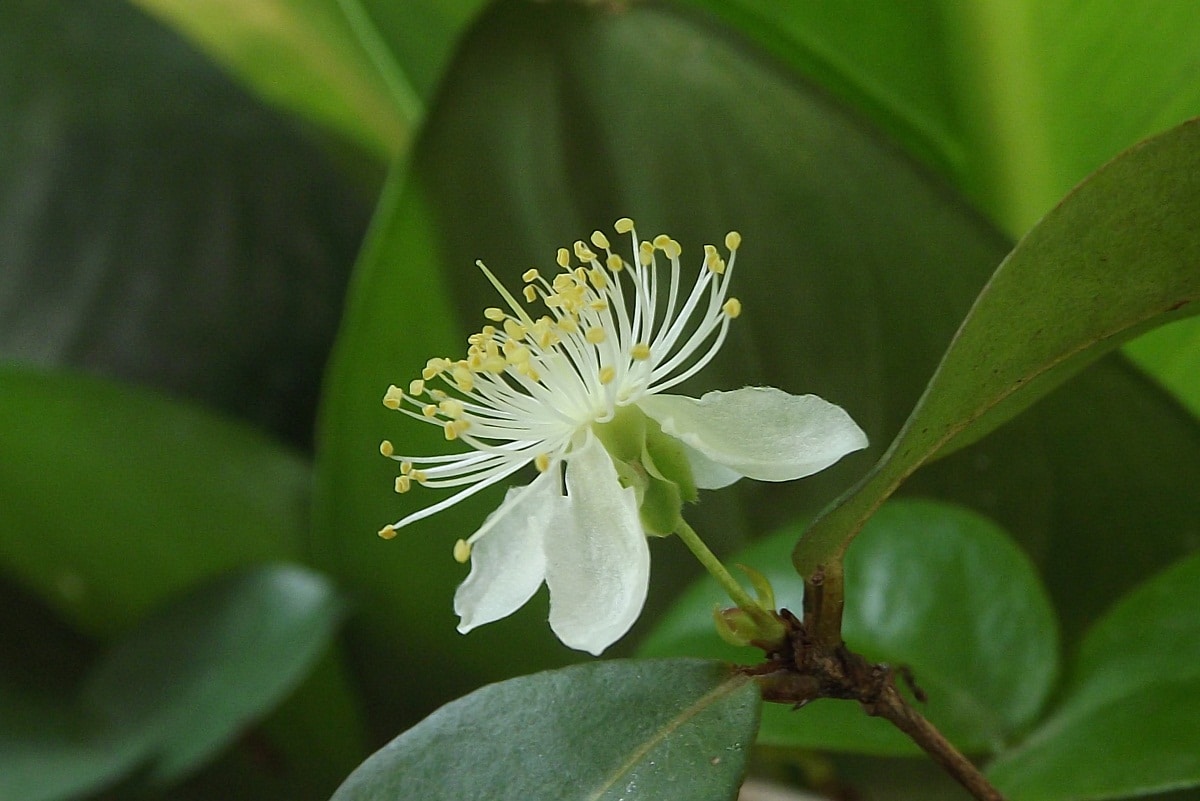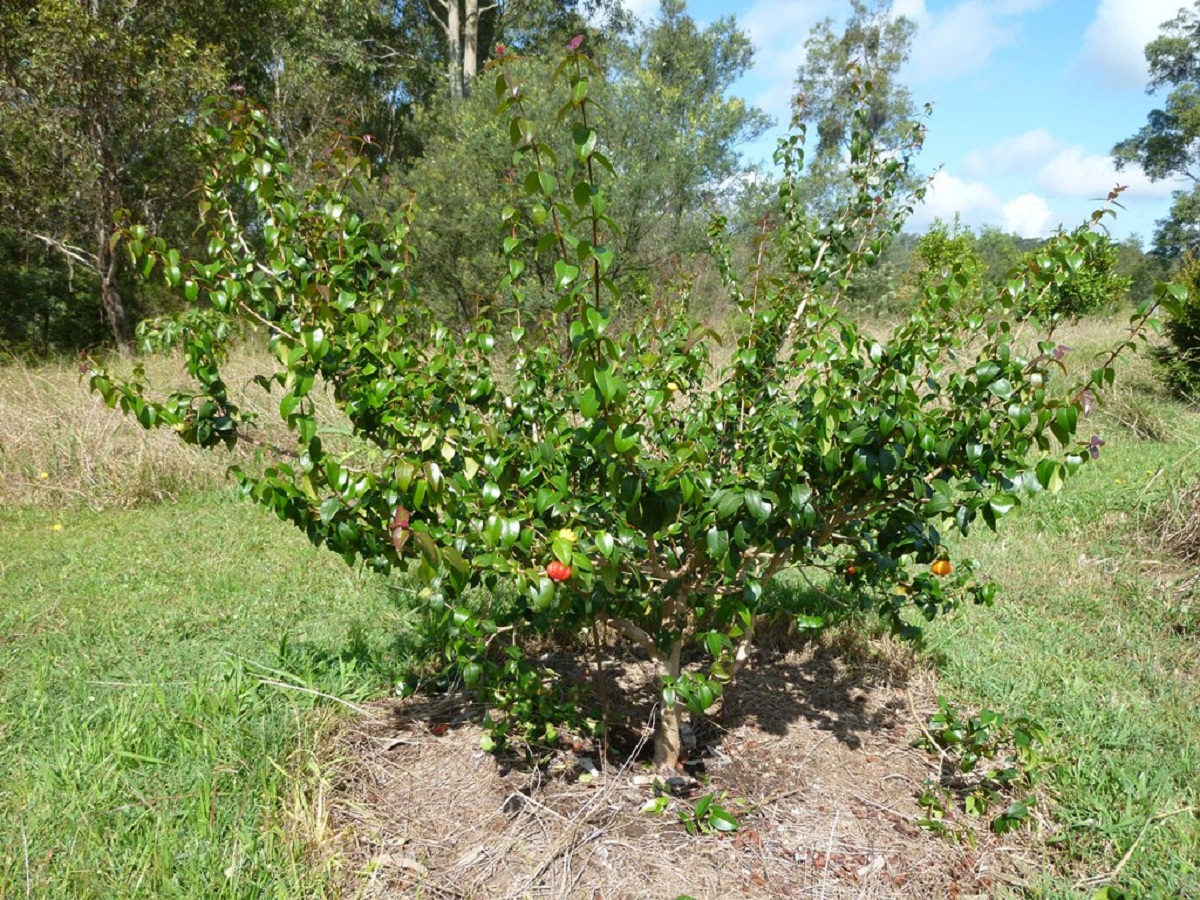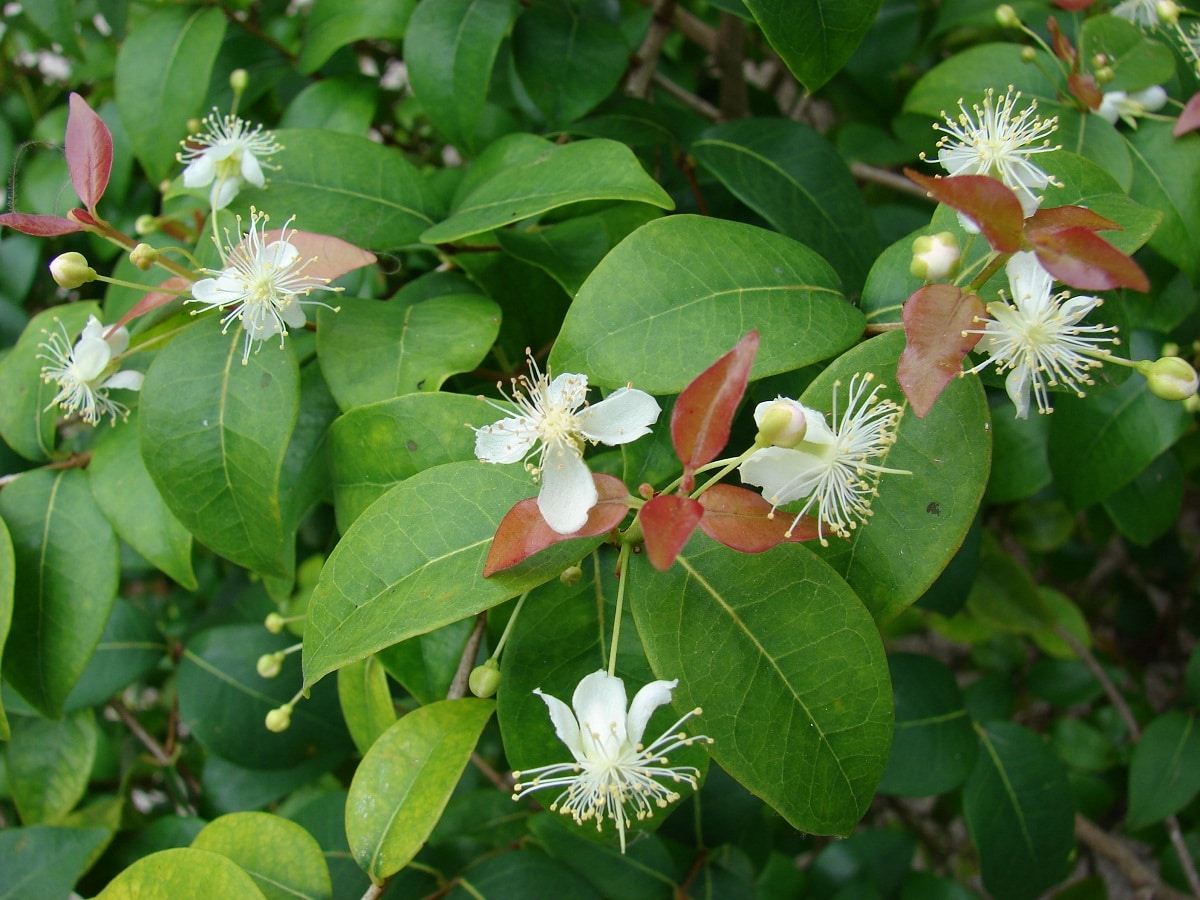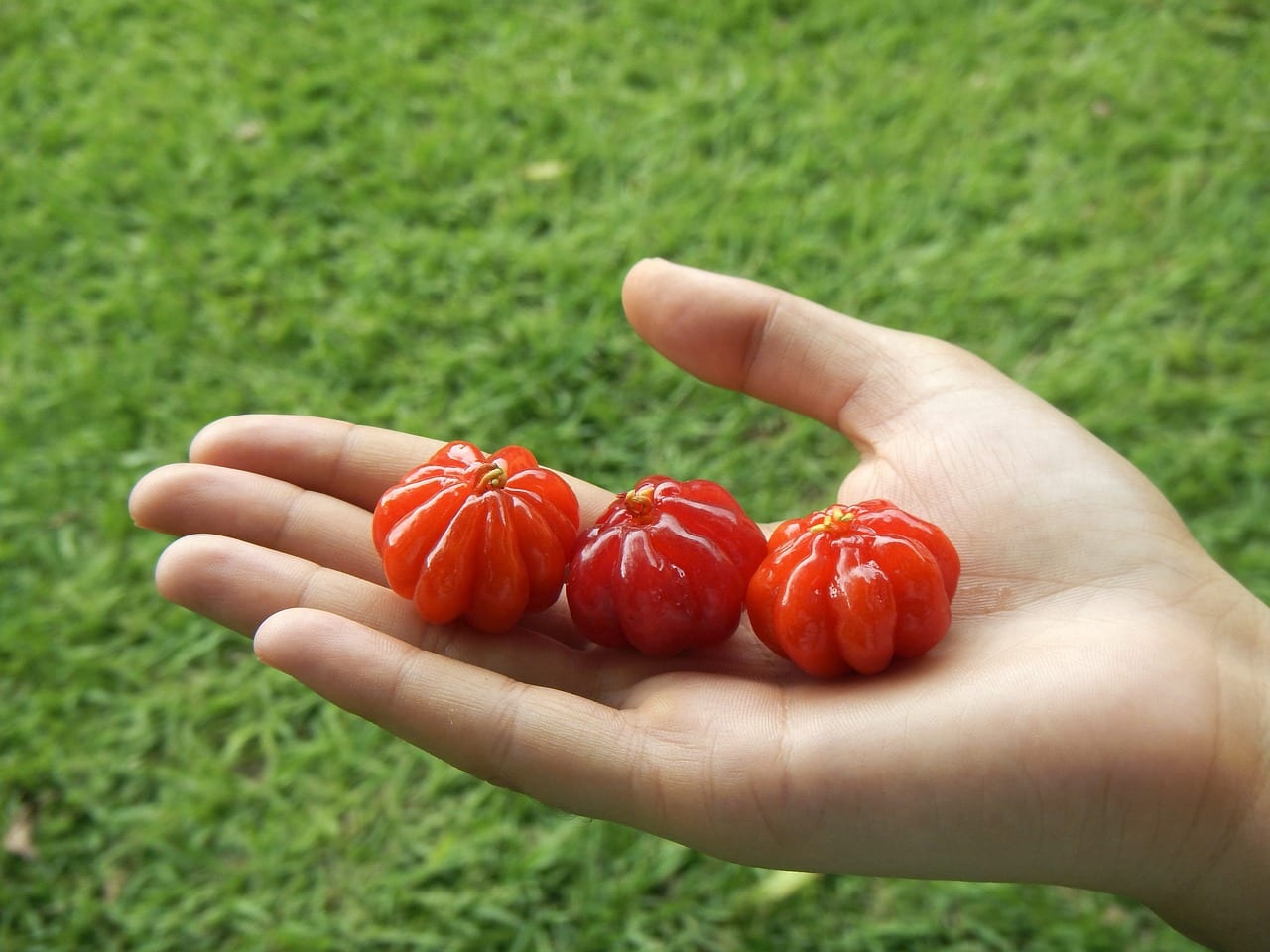
In recent times we are seeing fruits in supermarkets that we have never seen before, one of them being the pitanga. But what plant produces it? Can you stand the cold?
Our protagonist, whose scientific name is eugenia uniflora, is a shrub or small evergreen tree known by the common names of ñangapiry, capulí, currant, cherry, cayenne cherry, and also Pitanga.
Characteristics of the Pitanga

It grows in the rainforests of Argentina, Brazil, Paraguay, Bolivia and Uruguay. It reaches an approximate height of 7,5 meters. The leaves are simple, opposite, with the entire margin, bright green and 4 to 6,5 cm long.
Its flowers, which sprout in spring, are white. They can appear in groups or solitary. Once they are pollinated, the fruit begins to ripen, which is an edible oblate berry up to 4cm in diameter, with eight well-visible ribs. When it finishes maturing, it is deep red in color.
Inside there are normally a spherical seed, but there can be up to three. Its fruits grow in isolation, being able to give between ten and twenty fruits in the same cluster.
If the pitanga is cultivated in fences, this can withstand intense pruning, thus achieving a dense foliage from it, although the fruit production will be less than in those trees that have not been pruned.
Another interesting feature of this fruit is that has anticancer properties, thanks to the amount of antioxidants present in its pulp and skin.
The pitanga can be used to increase energy, as it contains a large amount of protein and carbohydrates, thus quickly replacing the energy lost during physical exercise.
You can use the skin of this fruit to treat colic, diarrhea, or symptoms of it.
In few occasions insects are seen to affect the pitanga, since its leaves have repellent characteristics, so they are also used to scare flies and other insects.
Thanks to the large amount of phosphorus it has, helps in the elimination of serious problems in the kidneys, as are free calculations.
What are the Pitanga leaves like
This plant has leaves that are simple, glabrous, opposite, ovoid in shape and deep green in color. The leaves of this tree are usually kept throughout the year, so it maintains its foliage permanently and it will remain its color all the time, even in autumn.
It will not be necessary that we can the pitanga tree, so the care that you will have to give will be much less than that of other plants in your garden. Also, thanks to the fact that the pitanga seeds do not attract birds, these will not be a problem for your crop.
How long does the pitanga take to bear fruit?
After you have done the process of growing the pitanga in your garden or space conditioned for it, you will have to arm yourself with patience to wait for the first fruits, since this plant will take three years to do so.
However, given all the benefits that we have told you about the pitanga, it is worth the wait, right?
How is it grown?
To be able to cultivate the pitanga you will not have to do a lot of work, but be very attentive to some things that allow your tree, flowers and fruits, have the right conditions in order to have a good harvest, especially during the ripening cycle, since the size and flavor of the fruit depends on it, as well as the size that the tree itself can reach.
The first thing you should know to grow pitanga, are the basic conditions that are necessary for this and which are the following:
- Location: it must be sown outdoors, in full sun or in semi-shade.
- Land: the necessary for the pitanga is not demanding, but it needs to have good drainage.
- Irrigation: you will have to drain it every 2 days in summer, and every 4-5 days the rest of the year.
- Subscriber: it is advisable to fertilize it with fertilizers rich in phosphorus to improve the quality of the fruit.
- Rusticity: supports up to -3ºC if it is for a short time.
Also, if you are interested in sowing pitanga, you have to do it with seeds that are literally newThose that have just germinated after a month of planting, since, otherwise, germination would be possibly interrupted.
When you go to water the plantation to the pitanga plant, first check that the soil is really dry, since this tree does not support land that has excess water, that are limestone or very saline. The best thing to do is add fertilizer watering at least once a week during spring and summer.
During the cultivation process, you will have to do maintenance to the plants, but don't worry, it is something extremely simple. Use a garden scissor to prune the pitanga tree, cutting those branches that are more deteriorated, but without pruning too much, because you can eliminate branches that have good wood for the growth of the fruit.
When you go to remove the fruit from the pitanga, do not pull it out, you just have to touch it and let it fall into your hand. Remember that the less you prune the tree, the more fruit you will get from it.
Is it suitable for interiors?
No, although the pitanga can develop almost anywhere, it must be located outdoors, since needs to be in contact with him or in semi-shadow, as well as having good water drainage.
If you have it inside your house, the safest thing is that the plant will not develop, its flowers and of course, neither will its fruits.
Is it suitable for low temperatures?
Low temperatures do not allow the pitanga to develop well, so, as you should plant it outside your house, the most advisable thing is that the climate of that place does not have temperatures below -3ºC, since below that temperature the plant will not resist.
Is it suitable for direct sun?
Although this plant can be planted outdoors where the sun shines directly on it, you have to consider that when it is a very hot season, it may not resist it, so it is best that you look for a place that has semi-shade or that In times where the sun has a high intensity, it cannot affect it.
Pitanga diseases and pests
Something that people also do not know is that the pitanga is one of the few plants that is not affected by any type of pest, thanks to the repellent characteristics it has, so it is totally unlikely that an insect or worse still, a pest, will want to be in it.
How to plant it

On many occasions, surely you limited yourself to growing your trees because you thought that a garden or a large area of land was necessary for it, when the reality is that you can start with a simple pot for it.
As the dimensions of the pitanga will not be greater than 7,5 meters, we can place it perfectly in a pot, which must be enabled to drain the little water that it requires to maintain itself.
Use the newly sprouted seeds of another pitanga plant that you have or that a neighbor has, bury it in the pot 1 cm deep and in a short time you will begin to see the tree grow. In addition, you will have to add fertilizer rich in phosphorus so that the fruits of this plant can be given properly, in terms of flavor and size.
Uses of the pitanga
We are talking about a fruit that is edible and that has, as we have already mentioned, many properties that are beneficial to health, thanks to the large amount of vitamins, phosphorus, iron and calcium it has.
The pitanga fruit can be eaten whole, or split. It can be used for the preparation of jams, preserves, juices or infusions, as it can also benefit you with its medicinal properties to treat digestive problems, diuretics, among others.
Another use that is given in the food industry, although it is more in the liquor part, is for the preparation of alcoholic beverages such as brandy.
Beyond the edible, with the pitanga perfumes are also made and even anti-inflammatories to soothe sore gums.
The leaves are also taken as an infusion. To do this, you just have to put them in a shady place, and wait for them to dry. Then, you can put them in a saucepan with water until it boils.
Of course, it is used as an ornamental plant. Its size and its flowers are very decorative, and as it does not take up much space it you can have in small-medium gardens.
All the already mentioned properties of the pitanga, they may have prompted more attention and that their crops will reach regions where they have never known of her before.

As you have seen throughout the article, the pitanga is a fruit that has many properties that we can useBesides, cultivating it is nothing to write home about, so we could well have it in the garden of our houses.
If you are interested in growing pitanga, follow our practical tips for it, which we are sure will help you. But if you need the healing properties of this, it is also a way to start to know more about it.
About 7 years ago we had one in the garden ... it has never flowered or borne fruit ... why could it be? Thanks
Hello Gustavo.
Have you paid it? Lack of nutrients can delay flowering. You can pay it with guano, which has a fast effectiveness.
A greeting.
Hello, I have a pitanga, for now it is small, it measures 60 cm and the leaves are turning brown and yellow with spots, what can I do?
Hi Patricia.
How often do you water it? It is very important to water little, 2-3 times a week in summer and every 10-15 days the rest of the year, since otherwise you could have problems derived from excess watering, such as root and stem rot.
Also, you should only water the soil, never the leaves. If you have it in a pot with a plate underneath, it is better to remove that plate as stagnant water could also rot the roots.
If you have doubts, tell us 🙂
Greetings.
I have a plant and it gives me many fruits as in the photo every year it is still impressive what the tree carries ,,,, but my question ,, in what time can I prune it? I am from Uruguay, I put the country because it changes the seasons , I hope as soon as possible the answer thanks ,,, Nestor
Hi Nestor.
You can prune it if necessary in late winter.
Regards!
Hello, here in Costa Rica we have Pitangas in the Central Valley, I don't know how they got here, but those of us who know them appreciate them very much. Here in my house we have a tree that is about 100 years old, and every year between June and July it gives an abundant harvest. However, in all these years we have not managed to get any of its seeds to germinate, why is it?
regards
Hi Kenneth.
It is curious what you comment. It may be that they give infertile seeds, or that at the time of sowing them or taking care of the seedbed, something is being done that prevents their germination.
Anyway, you can also try to sand the seeds a little before sowing them. This could stimulate their germination 🙂
Greetings.
Hello Monica, I am writing to tell you that I followed various tips and planted 20 seeds in different ways, and of the 20, 14 have germinated successfully, quite an achievement. Thanks a lot!
Hi Kenneth.
Great, we're really happy about that. Enjoy your pitangas! 🙂
Greetings.
I have a tree whose fruit is similar to the pitanga but it is orange, acidic, its flesh is soft, it has large seeds and the fruit is mostly the size of an egg. Here we call it quince but in reality we are not certain of the name. Its flavor is exquisite and its smell is similar to a wild plum and there is a taste and smell of peach juice. Tell me if you can help me know what the fruit is and where in the photos. Thanks.
I have a beautiful ñangapyri tree about 6 years old and birds love fruits.
Good afternoon, I have some pitanga trees, and on the branches it began to form as black grains, kind of like warts, it does not affect the development of the plant, but I do not know what it is, and I cannot find information to know if it is a disease or lack of any nutrient or pH, it extends to other smaller trees that were born later, I appreciate if someone can understand me and what it could be about, thank you
Hello Walter.
Those pimples, can you remove them with your fingernail? If so, they are mealybugs and are treated with anti-mealybug insecticides, or with these home remedies (click here).
If they are NOT gone, then they are probably fungi, and they are treated with fungicides.
Greetings.
Hello Monica, I have a very small plant in my garden and now it is full with some plague, maybe fungi, which spread on the leaves and ends up covering them all, they are white to pink in color. Could you tell me what to fight them with?
Hello Maria Jose.
Have you tried to see if they can be removed with the nail? If so, they are almost certainly mealybugs, and not fungi. There are many types of mealybugs, but the most common are cottony and ribbed. You can remove them by cleaning the leaves with soap and water, but if you can I would recommend getting diatomaceous earth (they sell it in amazon for example).
You spray the plant with water when the sun is out, and then add the diatomaceous earth. It leaves no residue and is not toxic to humans or pets.
Regards!
Hello. I want to plant a silver pitanga on my balcony, I don't know if it is possible to grow it in a pot. If so, where could I get it in Colombia? I live in Sasaima, Cundinamarca, Colombian. Thanks.
Hello Rubí.
Taking into account that it grows to almost 8 meters, we do not recommend growing it in a pot. But if you are pruning its branches once a year, always a little so that it does not grow much, then cultivation in a pot is viable. We can advise you with this if you wish, via Facebook or email to Contact@jardineriaon.com
About your last question, I don't know how to tell you. We are in Spain and I don't know where they sell in Colombia. Maybe you can ask at a nursery in your area.
Greetings.
Three years ago I planted a pitanga, this year it gave flowers but the fruits did not form. I would like to know the reason. Thank you
Hello Bettina.
Sometimes it happens that he is simply young. There have to be more patience.
If it's well taken care of, I wouldn't worry about it.
A greeting.